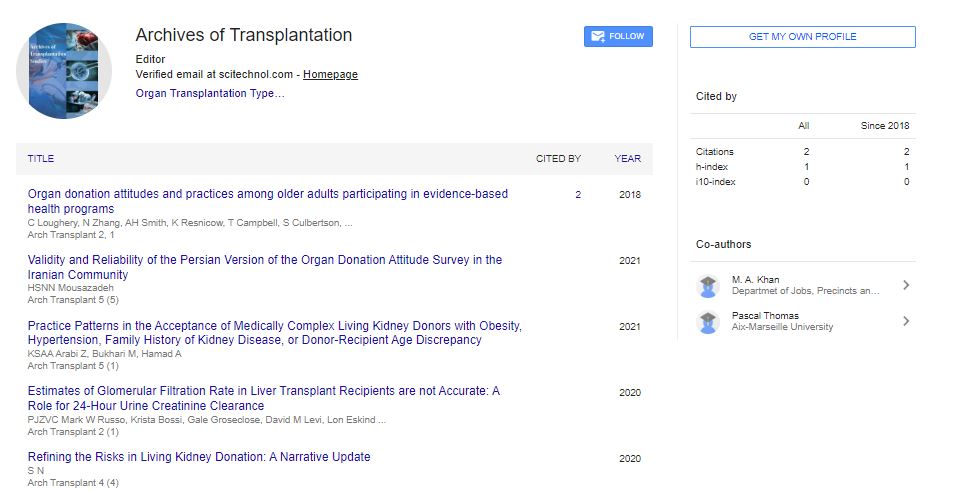Perspective, Arch Transplant Vol: 7 Issue: 3
Advancing Liver Transplantation: Bold Innovations Transforming the Field
Chloe Lee*
1Department of Medicine, Baylor College of Medicine, Houston, USA
*Corresponding Author: Chloe Lee,
Department of Medicine, Baylor College
of Medicine, Houston, USA
E-mail: chole_lee5@gmail.com
Received date: 02 September, 2023, Manuscript No. AT-23-116169;
Editor assigned date: 04 September, 2023, PreQC No AT-23-116169(PQ);
Reviewed date: 18 September, 2023, QC No AT-23-116169;
Revised date: 25 September, 2023, Manuscript No AT-23-116169(R);
Published date: 05 October, 2023, DOI: 10.4172/AT.1000151.
Citation: Lee C (2023) Advancing Liver Transplantation: Bold Innovations Transforming the Field. Arch Transplant 7:3.
Abstract
Description
Liver transplantation is a life-saving procedure that has evolved significantly over the years. This manuscript provides an overview of the current state of liver transplantation, highlighting key advancements in surgical techniques, organ preservation, immunosuppression, and donor allocation. It also explores future prospects in the field, including regenerative medicine, xenotransplantation, and innovative therapies. As liver transplantation continues to improve and expand, it offers hope to patients with endstage liver disease and other liver-related conditions.
Liver transplantation is a well-established and highly successful treatment option for patients with end-stage liver disease, acute liver failure, and certain liver-related malignancies. Since the first successful liver transplant in 1967, the field has witnessed remarkable advancements in various aspects of the procedure and its associated technologies.
Current state of liver transplantation
Surgical techniques: Advancements in surgical techniques have significantly improved the outcomes of liver transplantation. Minimally invasive procedures, such as laparoscopic donor hepatectomy, have reduced postoperative pain and shortened recovery times for living donors. Innovations in surgical instruments and approaches have also contributed to enhanced patient care.
Organ preservation: The development of advanced methods for organ preservation has extended the viability of donor livers. Machine perfusion techniques and hypothermic preservation have improved the assessment of organ quality and increased the utilization of marginal donor organs, leading to better overall transplantation outcomes.
Immunosuppression: Immunosuppressive therapies have become more precise and effective, striking a balance between preventing graft rejection and minimizing side effects. Individualized immunosuppression regimens tailored to each patient's specific needs are now common practice, offering improved long-term outcomes and quality of life.
Donor allocation: The Model for End-Stage Liver Disease (MELD) system has revolutionized organ allocation by prioritizing patients based on their medical urgency. Additionally, the utilization of Expanded Criteria Donors (ECD) and organs from Donation after Circulatory Death (DCD) has expanded the pool of available organs, addressing the persistent issue of organ shortage.
Regenerative medicine: Regenerative medicine holds tremendous potential for reducing the reliance on donor organs. Ongoing research into liver organoids, induced Pluripotent Stem Cells (iPSCs), and tissue engineering aims for the functional liver tissues ex vivo. These approaches have the potential to revolutionize the field by providing an alternative to traditional transplantation.
Xenotransplantation: Xenotransplantation, the transplantation of organs from animals into humans, is a groundbreaking avenue of research. Pigs, due to their physiological similarities to humans, are the primary focus of this research. Successful xenotransplants could offer a sustainable and readily available source of organs, though significant scientific and ethical challenges remain.
Innovative therapies: Advancements in innovative therapies, such as cell-based therapies and bioengineered organs, have the potential to improve organ transplant outcomes further. These therapies may enhance graft survival, reduce complications, and extend the functional lifespan of transplanted organs.
Organ allocation: Ensuring equitable organ allocation remains a major ethical concern, particularly in the face of organ scarcity. Ethical principles of justice and fairness must guide allocation decisions.
Informed consent: The informed consent process, for both donors and recipients, must continue to prioritize transparency and comprehensive understanding of risks and benefits. Ethical practices in obtaining consent are essential to upholding the autonomy and wellbeing of all involved parties.
 Spanish
Spanish  Chinese
Chinese  Russian
Russian  German
German  French
French  Japanese
Japanese  Portuguese
Portuguese  Hindi
Hindi 